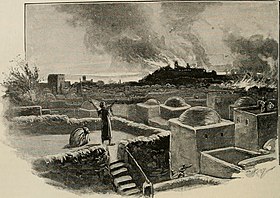|
تضامنًا مع حق الشعب الفلسطيني |
حصار البابليون للقدس
| ||||
|---|---|---|---|---|
لوحة القدس تحترق (من الكتاب المقدس الفني عام 1896)
| ||||
| المكان | القدس | |||
| التاريخ | 589-587 قبل الميلاد | |||
| المشاركين | نبوخذ نصر الثاني، والبابليون | |||
| النتائج | انتصار البابليون، وتدمير هيكل سليمان، وبداية السبي البابلي | |||
| تعديل مصدري - تعديل | ||||
فرض الإمبراطور البابلي نبوخذ نصر الثاني حصاراً على القدس عاصمة مملكة يهوذا في الفترة ما بين عامي 589-587 قبل الميلاد خلال آخر الثورات اليهودية ضد بابل. استمر حصار البابليون للقدس لمدة 30 شهرًا قبل أن تسقط في أيدي البابليين الذين دمّروا المدينة بشكل منهجي وهدموا المعبد الأول، كما قاموا بحل مملكة يهودا وبنفي العديد من سكانها إلى بابل.[1][2]
أصبحت يهوذا مملكة تابعة للإمبراطورية البابلية خلال أواخر القرن السابع قبل الميلاد. وفي عام 601 قبل الميلاد، ثار يهيواقيم ملك يهودا ضد الحكم البابلي على الرغم من التذاكر القوية للنبي إرميا.[2][3] توفي يهيواقيم بعد ذلك لأسباب غير واضحة، وخلفه ابنه يهويا كين.[4][5] في 597 قبل الميلاد حاصر البابليون القدس تحت قيادة ملك الإمبراطورية الجديدة في بابل نبوخذ نصر الثاني،[2][6] واستسلمت المدينة، فنهبت وتم ترحيل يهويا كين والعديد من المواطنين البارزين لبابل، وتم تنصيب صدقيا عم يهويا كين كملك ليهوذا.[2][7] قاد صدقيا في وقت لاحق ثورة ثانية بتشجيع من المصريين فتم إرسال جيش البابلي لاستعادة القدس.[2]
تمكّن البابليون من الاستيلاء على القدس في 25 آب (أغسطس) عام 587 قبل الميلاد أو 18 تموز (يوليو) عام 586 قبل الميلاد، وقاموا بتدمبر المعبد الأول وأحرقوا المدينة،[1][2][8] ثُم دمروا المستوطنات الصغيرة المحيطة بالمدينة، وتلك القريبة من الحدود الغربية للمملكة.[8] حاول صدقيا الهرب وفقًا لرواية الكتاب المقدس ولكن قُبض عليه بالقرب من أريحا، وأُجبر على مشاهدة إعدام أبنائه في ريبل، ثم فقأت عينيه.[9]
أدى تدمير القدس ومعبدها إلى أزمة دينية وروحية وسياسية تركت بصماتها في الأدب النبوي والتقاليد التوراتية،[8][9] وانتهت مملكة يهوذا بضمها كمقاطعة تابعة للإمبراطورية البابلية مع مركزها في ميزبه،[2][8][9] وتم نفي نخبة يهودا ومن بينهم أبناء سلالة النبي داود، إلى بابل.[8] وبعد أن سقطت بابل في يد كورش الكبير مؤسس الإمبراطورية الأخمينية الفارسية في عام 539 قبل الميلاد، سمح لدوانس المنفيين بالعودة إلى صهيون وإعادة بناء القدس. تم الانتهاء من بناء المعبد الثاني في عام 516 قبل الميلاد.
الخلفية التاريخية
الحصار
التداعيات
المراجع
- ^ أ ب Finkelstein، Israel؛ Silberman، Neil Asher (2002). The Bible Unearthed: Archaeology's New Vision of Ancient Israel and the Origin of Its Sacred Texts. New York: Free Press. ص. 307. ISBN:0-684-86912-8. OCLC:44509358. مؤرشف من الأصل في 2023-03-26.
Intensive excavations throughout Jerusalem have shown that the city was indeed systematically destroyed by the Babylonians. The conflagration seems to have been general. When activity on the ridge of the City of David resumed in the Persian period, the-new suburbs on the western hill that had flourished since at least the time of Hezekiah were not reoccupied.
- ^ أ ب ت ث ج ح خ Bickerman, E. J. (2007). Nebuchadnezzar And Jerusalem (بEnglish). Brill. ISBN:978-90-474-2072-9. Archived from the original on 2022-09-29.
- ^ Malamat, A. (1975, January). The twilight of Judah: in the Egyptian-Babylonian maelstrom. In Congress Volume Edinburgh 1974 (pp. 123–145). Brill.
- ^ Smit، E. J. (1 يناير 1994). "So how did Jehoiakim die?". Journal for Semitics. ج. 6 ع. 1: 46–56. hdl:10520/AJA10318471_285. مؤرشف من الأصل في 2023-01-29.
- ^ Begg، C. (1 يناير 1996). "The end of King Jehoiakim: the afterlife of a problem". Journal for Semitics. ج. 8 ع. 1: 12–20. hdl:10520/AJA10318471_366. مؤرشف من الأصل في 2023-05-18.
- ^ Geoffrey Wigoder, The Illustrated Dictionary & Concordance of the Bible Pub. by Sterling Publishing Company, Inc. (2006)
- ^ The Oxford History of the Biblical World, ed. by Michael D Coogan. Published by Oxford University Press, 1999. p. 350
- ^ أ ب ت ث ج Lipschits، Oded (1999). "The History of the Benjamin Region under Babylonian Rule". Tel Aviv. ج. 26 ع. 2: 155–190. DOI:10.1179/tav.1999.1999.2.155. ISSN:0334-4355. مؤرشف من الأصل في 2023-01-29.
The destruction of Jerusalem by the Babylonians (586 B.C.E.) is the most traumatic event described in biblical historiography, and in its shadow the history of the people of Israel was reshaped. The harsh impression of the destruction left its mark on the prophetic literature also, and particular force is retained in the laments over the destruction of Jerusalem and the Temple in its midst. [...] most of Judah's inhabitants remained there after the destruction of Jerusalem. They concentrated chiefly in the Benjamin region and the northern Judean hill country. This area was hardly affected by the destruction, and became the centre of the Babylonian province with its capital at Mizpah. [...] The archaeological data reinforce the biblical account, and they indicate that Jerusalem and its close environs suffered a severe blow. Most of the small settlements near the city were destroyed, the city wall was demolished, and the buildings within were put to the torch. Excavation and survey data show that the western border of the kingdom also sustained a grave onslaught, seemingly at the time when the Babylonians went to besiege Jerusalem.
- ^ أ ب ت Smith-Christopher، D. L. (1 يناير 1997)، "Reassessing the Historical and Sociological Impact of the Babylonian Exile"، Exile: Old Testament, Jewish, and Christian Conceptions، Brill، ص. 7–21، DOI:10.1163/9789004497719_008، S2CID:244932444، مؤرشف من الأصل في 2023-01-28، اطلع عليه بتاريخ 2022-05-24


